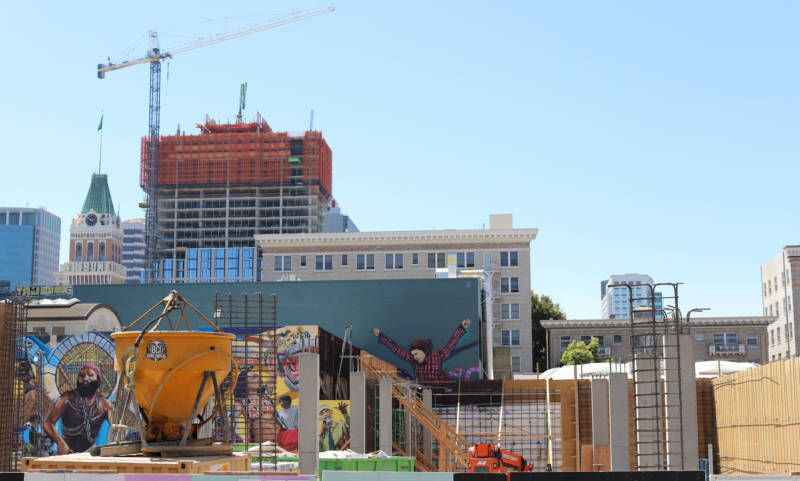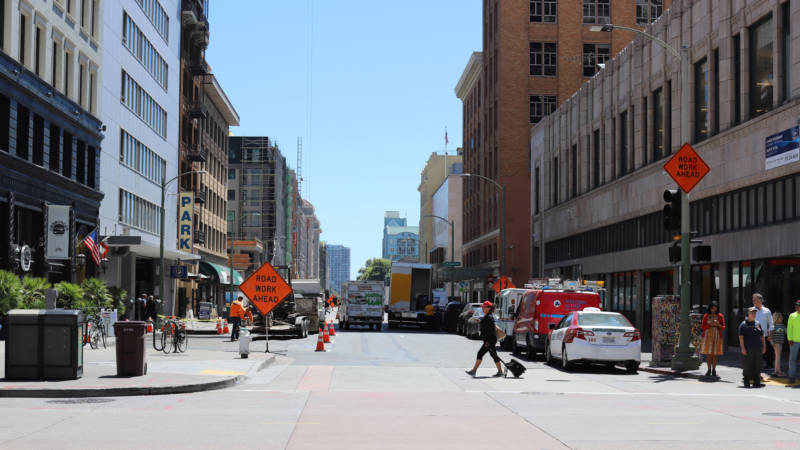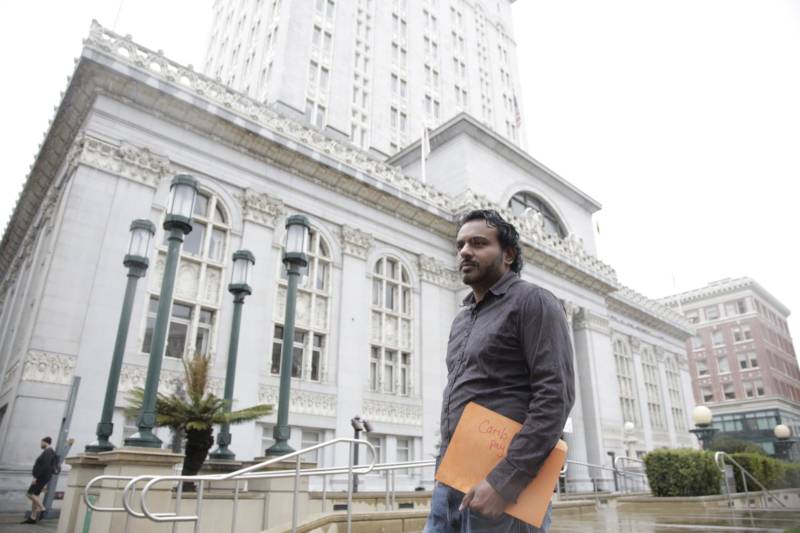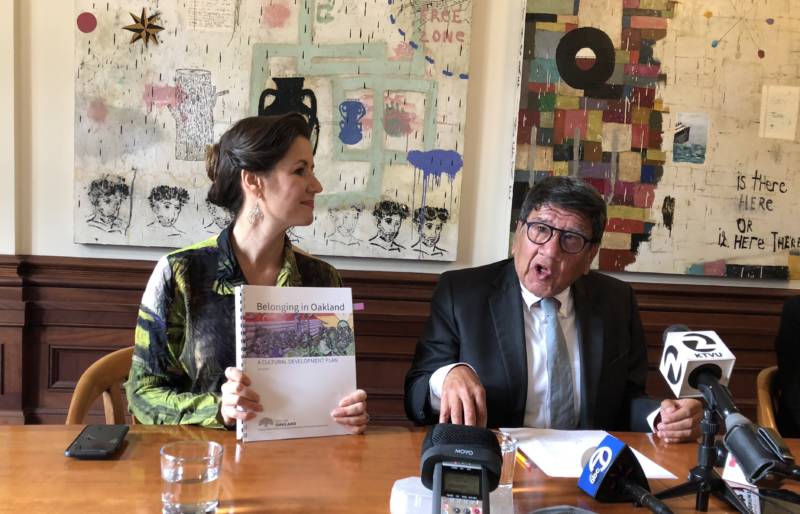The City of Oakland has released a 342-page review draft of its Downtown Oakland Specific Plan (DOSP), a policy framework for development, transportation and public space as well as cultural arts in its rapidly changing urban core, and officials are now soliciting public feedback.
Will Oakland’s New Plan to Protect Downtown Arts and Culture Succeed?

It largely carries forward cultural stabilization strategies from similarly-aimed task forces and planning documents dating as far back as 2015 that local arts figures support but wish to see funded and implemented more swiftly than in recent years.
The document, four years in the making and projected for adoption in 2020, includes a raft of policy proposals to support arts and culture in the area approximately bounded by Lake Merritt, Interstate 980, 27th Street and the Oakland Estuary in a chapter entitled “Culture Keeping.”
It’s an area experiencing dramatic development, with thousands of housing units opening or under construction, and intense competition for commercial and office space. Changes to the built environment, along with downtown’s declining black population and an influx of affluent residents, pose challenges to nonprofits, galleries, venues and other cultural resources.
Downtown Oakland has 161 arts and culture businesses, institutions and nonprofits, 62 nightlife and entertainment establishments and 184 murals, according to the DOSP. “Unprecedented economic investment … has introduced a new dynamic in the cultural landscape that, left unaddressed, endangers this mosaic,” reads the chapter introduction.

The plan proposes formalizing unofficial cultural districts such as Chinatown and the cluster of galleries near the Oakland First Fridays street festival, plus allocating resources to the already-established Black Arts Movement and Business District (BAMBD). These districts would be incorporated into a network of public spaces with culturally-relevant streetscape elements.
Among the ten intersections listed for potential redesign is 13th Street between Broadway and Franklin Street. There the Downtown Oakland Association, a consortium of area property owners, plans to create a plaza to dissuade loitering, raising concerns about the organization’s swelling power to shape and police public space, as KQED previously reported.
Also proposed is requiring developers that displace arts and culture businesses to offer replacement space on-site or else offer relocation assistance; supporting land trusts and other collective ownership models to acquire and preserve properties for arts uses (along the lines of Shadetree); and offering more below-market-rate leases to galleries in city-owned properties similar to its deals with Pro Arts and Betti Ono.
The plan lists difficulties for entertainment venues to comply with special-events regulations including prohibitive costs and “racial bias in permitting and enforcement,” a reference to reports of Oakland cops’ double standards for hip-hop nightclubs that draw largely black audiences. In March city officials revoked New Karibbean City’s after-hours permit at the urging of Oakland police in what proprietor Richard Ali considered the latest example of discrimination against hip-hop venues.
Proposed regulatory fixes for downtown entertainment include a streamlined “one-stop shop” for permitting and revising what critics call selectively-enforced aspects of the municipal code pertaining to events.
Acknowledging tensions between nightlife operators and residents, the plan also floats an idea—similar to legislation San Francisco adopted in 2015—to protect entertainment venues against noise complaints from residents of newly-constructed buildings. For example, Oakland could proactively require developers to disclose the presence of entertainment venues near new apartments to prospective tenants or buyers.

The document incorporates ideas from the Cultural Plan published last year, the special events task force formed after the Dec. 2, 2016 Ghost Ship fire in East Oakland and an artist housing and workspace task force report published in 2015. Local arts figures laud many of the proposals, but worry Oakland lacks the resources and political will to follow through with investment and implementation.
Eric Arnold, BAMBD spokesperson and community advisor to the DOSP authors, called the document “aspirational,” noting many of the “Culture Keeping” strategies date back years. “The outcomes listed all sound great, but how do we get there?” He said, “There isn’t the urgency we need.”
Some of the DOSP proposals have gained momentum only to stall: The Black Arts Movement and Business District was established in 2016 but just recently received city funding—$75,000 for signage. Stakeholders in the Art + Garage District, as some call the First Fridays gallery cluster, campaigned for formal recognition in 2015, only to have the plan scuttled after area property owners objected, according to supporters.
Lonnie Lee, a key Art + Garage District promoter whose Vessel Gallery was displaced earlier this year, said she’s baffled that cultural districts are so prominent in the plan after her disheartening experience attempting to form one. “They just want the marketing value,” Lee said. “The districts are nothing without policies—a sign’s not going to keep you.”
The DOSP specifically identifies the city-owned Malonga Casquelourd Center for the Arts—a longtime hub for performing arts of the African diaspora, currently housing companies including SambaFunk! and Dimensions Dance Theater—as needing significant upgrades, noting tenants of the facility have complained of deferred maintenance and inadequate staffing since 1999.
“Many in the arts community recommended increasing overall funding for arts and culture programs, as well as direct financial assistance to local artists and artists of color,” the plan reads. As KQED previously reported, the Cultural Affairs Unit has launched new initiatives—embedding artists in city departments, reestablishing an arts commission—under the leadership of Cultural Affairs Manager Roberto Bedoya since 2016, yet earlier this year officials cut its grant-making budget by 17 percent.

“A lot of these strategies require a huge infusion of support for Cultural Affairs,” Arnold said. “If you don’t increase their funding, projects requiring their input aren’t really going to happen.”
One solution, according to the plan, is to increase the Cultural Funding Program’s share of Oakland’s hotel or transient occupancy tax, although this would require a ballot measure. “That’s a big lift,” said Arnold. “You have community support, but you need political will, money to get it on the ballot and a campaign to draw attention—and the hotel industry will fight back.”
The DOSP also proposes contributing public funds to another round of real-estate holding nonprofit Community Arts Stabilization Trust’s “Keeping Space—Oakland,” which launched late 2016 to provide precarious local arts organizations financial and technical assistance; the first round was philanthropically financed. Oakland’s increasingly close partnership with CAST has previously stirred concerns of Cultural Funding Program responsibilities being outsourced or privatized.
The DOSP, developed with input from community advisory and stakeholder groups and public surveys, is still subject to change and requires approval from the Oakland City Council for adoption.
Events for the public to learn more and provide feedback on the document are scheduled for Thursday, Sept. 19 at Latham Square Plaza and Sunday, Sept. 29 at the Jack London Farmers Market. The Oakland Chinatown Chamber of Commerce, Jack London Improvement District and Old Oakland Neighbors are also hosting informational events throughout September.

